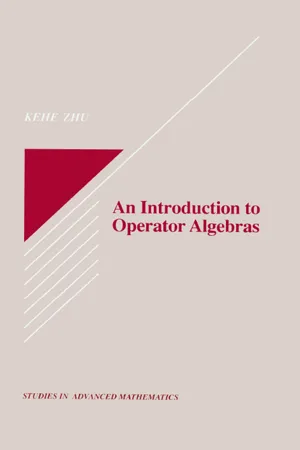
- 176 pages
- English
- ePUB (mobile friendly)
- Available on iOS & Android
eBook - ePub
An Introduction to Operator Algebras
About this book
An Introduction to Operator Algebras is a concise text/reference that focuses on the fundamental results in operator algebras. Results discussed include Gelfand's representation of commutative C*-algebras, the GNS construction, the spectral theorem, polar decomposition, von Neumann's double commutant theorem, Kaplansky's density theorem, the (continuous, Borel, and L8) functional calculus for normal operators, and type decomposition for von Neumann algebras. Exercises are provided after each chapter.
Frequently asked questions
Yes, you can cancel anytime from the Subscription tab in your account settings on the Perlego website. Your subscription will stay active until the end of your current billing period. Learn how to cancel your subscription.
At the moment all of our mobile-responsive ePub books are available to download via the app. Most of our PDFs are also available to download and we're working on making the final remaining ones downloadable now. Learn more here.
Perlego offers two plans: Essential and Complete
- Essential is ideal for learners and professionals who enjoy exploring a wide range of subjects. Access the Essential Library with 800,000+ trusted titles and best-sellers across business, personal growth, and the humanities. Includes unlimited reading time and Standard Read Aloud voice.
- Complete: Perfect for advanced learners and researchers needing full, unrestricted access. Unlock 1.4M+ books across hundreds of subjects, including academic and specialized titles. The Complete Plan also includes advanced features like Premium Read Aloud and Research Assistant.
We are an online textbook subscription service, where you can get access to an entire online library for less than the price of a single book per month. With over 1 million books across 1000+ topics, we’ve got you covered! Learn more here.
Look out for the read-aloud symbol on your next book to see if you can listen to it. The read-aloud tool reads text aloud for you, highlighting the text as it is being read. You can pause it, speed it up and slow it down. Learn more here.
Yes! You can use the Perlego app on both iOS or Android devices to read anytime, anywhere — even offline. Perfect for commutes or when you’re on the go.
Please note we cannot support devices running on iOS 13 and Android 7 or earlier. Learn more about using the app.
Please note we cannot support devices running on iOS 13 and Android 7 or earlier. Learn more about using the app.
Yes, you can access An Introduction to Operator Algebras by Kehe Zhu in PDF and/or ePUB format, as well as other popular books in Mathematics & Applied Mathematics. We have over one million books available in our catalogue for you to explore.
Information
Part II
C*-ALGEBRAS
8
C*-Algebras
8.1 The DEFINITION
DEFINITION 8.1 A C* -algebra is a Banach algebra together with a mapping x ↦ x* on satisfying the following conditions:
(a) (x*)* = x for all x ∈ .
(b) (ax + by)* = āx* + b̄y* for all x, y ∈ and a, b ∈ C.
(c) (xy)* = y*x* for all x, y ∈ .
(d) ‖x*x‖ = ‖x‖2 for all x ∈ .
Any mapping x ↦ x* on an algebra satisfying (a), (b), and (c) is called an involution on the algebra. The element x* is usually called the adjoint of x.
We point out that condition (d) above is the most stringent condition in the definition of a C*-algebra.
The involution in a C* -algebra is an isometry. In fact, for every x in we have
so that ‖x‖≤ ‖x*‖. Replacing x by x* we conclude that ‖x*‖≤ ‖x‖ and hence ‖x‖ = ‖x*‖.
It can also be shown that any involution x ↦ x* satisfying ‖x‖ ≤ ‖x*x‖ must be an isometry. In fact, this condition gives
and hence ||‖x‖≤ ‖x*‖. This implies that ||‖x‖ = ‖x*‖.for all x in .
Let 1 be the (multiplicative) unit in a C*-algebra . For every x in we have
By the uniqueness of the unit in an algebra, 1* = 1.
It is easy to check that an element x in a C*-algebra is invertible if and only if x* is. In t...
Table of contents
- Cover
- Half Title
- Title Page
- Copyright Page
- Dedication
- Table of Contents
- Preface
- I Banach Algebras
- II C*-Algebras
- III Von Neumann Algebras
- Bibliography
- Index